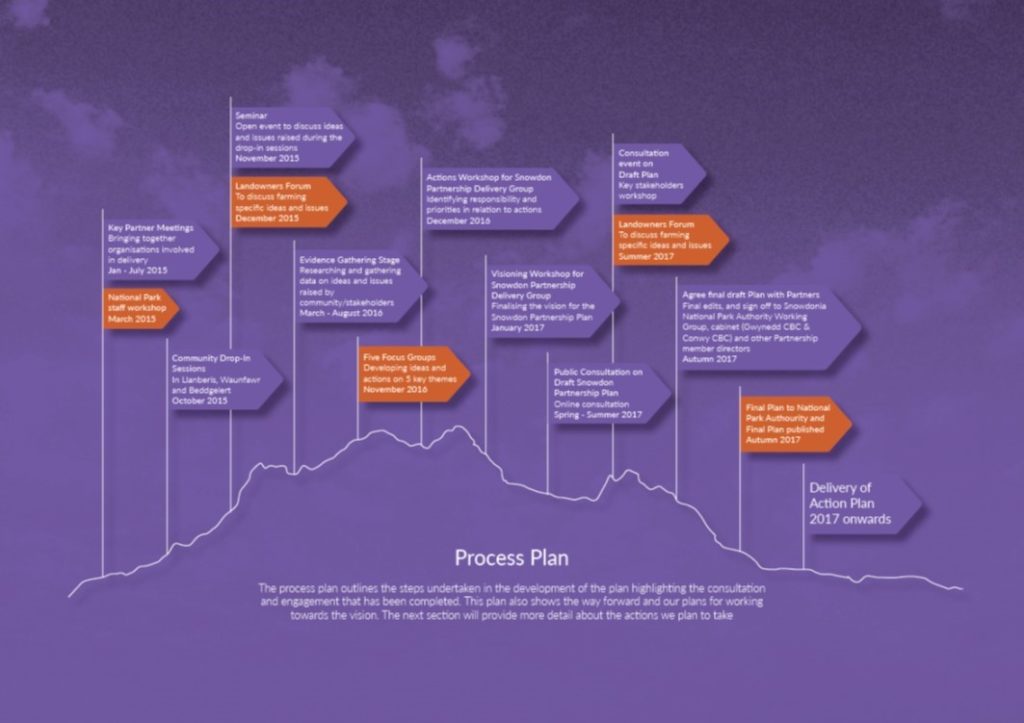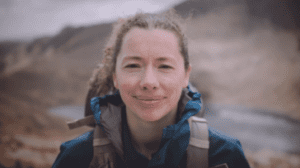Peace keeping in the mountains of Snowdonia: The Snowdon Partnership
© Snowdonia National Park, Wales,UK
Snowdon is the most popular mountain in the UK, and the effect this has on people who work and live in the area is significant. Helen Pye, National Park Partnerships Manager at Snowdonia National Park shares with us how The Snowdon Partnership is working together for the future of the mountain, and gives you a step-by-step guidance on how you can also do it in your Park! An article from our EUROPARC journal Protected Areas In-Sight 2017.
Peace-keeping in the Mountains of Snowdonia
Article issued by Helen Pye
Snowdon, Yr Wyddfa in Welsh (pronounced uhr-with-va), is a globally renowned, iconic mountain. It is home to vibrant, energetic communities and a mosaic of upland hill farms. It is a national asset, the most visited mountain in the UK, attracting over half a million people from across Wales, the UK and around the world every year. Caring for Yr Wyddfa is a complex business, requiring close collaboration in the work that we do.
In 2015 the issues affecting the area as a result of its immense popularity with visitors where reaching a crunch point. Parking problems were significantly affecting the local communities of the area, paths were being heavily eroded, litter was a major problem on the mountain and there was a general feeling amongst the public that things just weren’t working. Snowdon regularly made the news in local and national press, and not in a good way!
There was of course a huge amount of effort and great work going on to look after the mountain from all sorts of different organisations – both public, private and third sector, but there was no joined up, co-ordinated approach.
The Snowdonia National Park Authority decided to take a leading role in a more joined up approach to the management of the area, by developing a partnership management plan, which would set out the opportunities and threats we all wanted to tackle over the coming years.

From this very beginning point, to the point we are at now – with an agreed Plan in place – there were some fundamental ingredients that were key to the success of the process:
1) Identify the key players. Who are the key influencers in the area?
It was really important to design a plan that all our stakeholders supported and agreed on. Over the years, different types of groups in the area had become quite disparate in their views. In order to successfully influence and get people on board, we identified and established communications with key players in the area.
As well as a core group of officers (see point 3 below) we also identified all the – that is anyone who had some stake, role or interest in the way we as partners cared for the mountain, and then from these identified the key influencers and a clear communication strategy.
2) Find the one outcome that everyone agrees on (and cares about):
There will be an outcome that nearly everyone has in common. Sometimes it can be difficult to identify when moods are heightened! For Snowdon, it was that everyone wanted to care for the mountain and look after it for future generations. Once we’d identified this common outcome it was much easier to move things forward.
By creating and implementing a plan together, we could all be working towards the same goals.
3) Create a core partnership to drive the process forward
The group comprised of officers that represented all the organisations and landowners that are responsible for on-the-ground management of the mountain – ranging from conservation work and path management to tourism, farming and mountain rescue teams. We wanted to make sure that this core group where delivering on the ground and avoid it becoming a “talking shop”.
4) Develop the core partnership into a cohesive strong group
Point 2 above was the first and most important step in starting to bring the group together, along with other vital elements such as size of the group, meeting arrangements, dynamics and tone. Even the way you set out the room for a meeting is important!
5) Agree on – and then deliver – a genuinely open, transparent consultation process
This was about getting from where we were (no plan) to a point of delivery (an agreed partnership plan in place) in the most effective and efficient way. The diagram below sets out the process we took.
6) Demonstrate positive progress
During the process, we identified some ‘quick wins’ that could demonstrate positive progress. One of these was a pilot visitor giving scheme. It helped show stakeholders that physical progress was being made, whilst we were still discussing and creating the Plan.
7) Build clear responsibilities and ownership
Perhaps one of the most important steps we took was a ‘responsibility assigning’ workshop run for us by a fantastic consultancy company. This meant that responsibilities for action within the plan were very very clear. Fundamental for being able to successfully deliver the plan.
Watch also the Snowdonia Giving, a project to engage volunteers, young people and business for the common care of the Snowdon mountains.
And so here we are now with an agreed plan in place. The end of the beginning!
- To learn more about the Snowdon Plan visit www.snowdonpartnership.co.uk
It took two years to get to this point but has been hugely worth the effort. The turn-around in attitude and opinions of stakeholders has been quite incredible, and the momentum is really with us now. This makes everything so much easier and more efficient when it comes to delivering, when everyone is happy with the way forward.
 Helen Pye is happy to share information, knowledge, and advice in more detail. If you’d like to discuss anything further you can get in touch via e-mail: helen.pye @ eryri.llyw.cymru
Helen Pye is happy to share information, knowledge, and advice in more detail. If you’d like to discuss anything further you can get in touch via e-mail: helen.pye @ eryri.llyw.cymru

The Snowdon Partnership is funded by Snowdonia National Park with the support of Welsh Government, the National Trust and Snowdonia Society.